
Let’s start with strategy. Sure it’s a great term, but, what is it? What does it actually mean? When asked, most people pause and scratch their head. However, it’s important to understand strategy as something more than just an abstract concept. Successful brands don’t simply speculate about their strategies, they visualize them:

What is Strategy?
In its most basic form, strategy is the process of determining the best way to get from Point A to Point B. As a business, your challenge is to overcome the obstacles that stand between you and where you want to be. Taking the right actions helps to create a connection between your brand and your audience. The more your content sparks the needs of your audience the greater the likelihood you will create real brand loyalty.
A Short Course in Social Media Marketing
A good social media marketing plan usually involves these 12 vital steps. Among those steps, here are a few that are particularly crucial to driving your marketing efforts:
- Set goals and objectives
- Identify your audience (think personas)
- Focus on your offer and create killer content
- Execute flawlessly with social media tools with the highest potential for return
- Set metrics, evaluate, and fine-tune
Relationships are the New Currency – Platforms are the Enablers
As Peter F. Drucker said, “The purpose of a business is to create a customer.” More recently, Shiv Singh, Global Head of Digital for PepsiCo Beverages (@shivsingh) is credited with this quote: “The purpose of a business is to create a customer … who creates customers.” Today, relationships are the new emotional capital. Brands will win or fail based on their ability to identify, grow, sustain and convert loyal customers who become advocates of their brand.
Social media is all about creating and energizing relationships. However, does your business want a relationship with just about anyone who comes along? Not really. Your number one goal is to determine the audience with the best potential. In order to focus on the “who” you want to reach, first decide on the “what” (identify your business goals and objectives). Once you determine your goals and objectives, you realize that strategy begins with “who.” Who are you targeting with social media? Is it customers, prospects, analysts, the media, employees?
Create Personas to Increase Your Outreach & Engagement
What are personas? Basically, these are models of the different user types who may buy or influence the purchase of your products. Personas are derivatives of segmentation variables such as demographics, psychographics, and social behavior. You can determine your buyer persona by using primary and secondary research, social media behavior and judgment. Yes, judgment—the answers won’t all be served up neatly for you like a five course meal in a classy restaurant.
Your buyer personas will help you visualize your customers’ needs. Understanding your personas’ social media habits will enable you to create great content specifically tailored to their needs. How do they feel about your brand? Several social media monitoring tools (free and paid) will add more insight. Once you have determined a profile of the persona you want to pursue, you are ready to create a messaging strategy to reach them.
Quiz: Which Persona Provides a Better Picture for Content Development?
Example: Persona A
Female, age 21 to 34, single, no kids, no car, owns a microwave oven.
Example: Persona B
“Janet lives with her two Welsh Springer Spaniels in an apartment in lower Manhattan. She likes to go to Central Park at lunch time and walk along the lake. Her friends tease her about her large collection of matching purses and shoes. She uses her iPhone to tweet and update her status on Facebook. Janet has been on Facebook since she graduated college and wants to check out Google+ based on a tip from one of her twitter friends who loves the G+ Circles feature. When Janet has time, she writes a blog about her Welsh Springer Spaniels.”
Once you understand your persona’s needs, you are in an ideal position to craft an engaging message strategy. Goal number one is to deliver the right message to the right audience in the right place. You will define the right “place” based on an understanding of your personas’ social media buyer behaviors.
How “Social Proof” Can Help Architect Your Social Media Marketing Blueprint
According to Google, 70% of Americans now say they look at product reviews before making a purchase. However, product reviews are only one type of social proof. According to HubSpot, an Internet marketing services firm, “people can be heavily influenced by others’ experiences, making a case for why social proof is such a powerful concept for businesses to leverage.”
What is social proof? HubSpot describes “social proof” as the concept whereby “people will conform to the actions of others under the assumption that those actions are reflective of the correct behavior.” HubSpot’s social proof examples to use in your business marketing efforts include: social media mentions, social plug-ins, social media sharing/follow buttons, case studies and testimonials, user reviews and ratings, user generated content, social advertising and media, and blog mentions.
Take a Holistic View of Your Social Media Buyer Persona
Remember the importance of priorities. Knowing more about your personas enables you to create powerful content and the right digital experience. Work to understand the problems your brand can solve. Listen to and evaluate the language your personas use as they talk about both your brand and your competitors. Finally, work hard to determine what you want your audience to believe about your firm. Armed with this information, you will be in an ideal position to engage with relevant content that personalizes your brand in the minds of your customers and prospects.
This post was originally published on AT&T’s Networking Exchange Blog.













Mark, great article. The point about developing customer personas is a definite must for anyone wanting to practice effective SMM. A great technique is to develop these personas and run all your content ideas against them making the same judgements that you might expect to see from those personas.
That said it’s also important not to alienate other audience demographics, because while you will ultimately be targeting the customers who fit your persona profiles you will inevitably get “fans” who are not in those categories and to which you need to consider in your content strategy.
One other thing, the 12 vital steps anchor seems to link to the wrong page (/workshops_brands).
Thanks for your comments and glad you enjoyed the #MMchat sponsored by @TheSocialCMO on a very interesting topic.
Cheers.
Mark